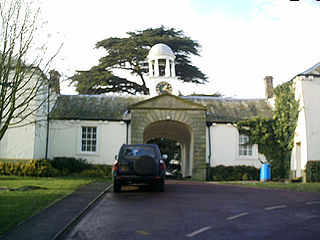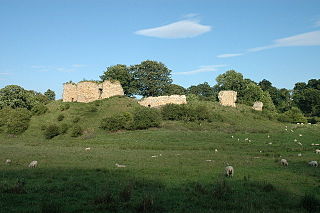
A manor house was historically the main residence of the lord of the manor. The house formed the administrative centre of a manor in the European feudal system; within its great hall were held the lord's manorial courts, communal meals with manorial tenants and great banquets. The term is today loosely applied to various country houses, frequently dating from the late medieval era, which formerly housed the landed gentry.

Osterley Park and House is a Georgian country estate in west London, that straddles the London boroughs of Ealing and Hounslow. Originally dating from the 1570s, the estate contains a number of Grade I and II listed buildings, with the park listed as Grade II*. The main house was remodelled by Robert Adam between 1761 and 1765. The National Trust took charge of Osterley in 1991 and the house and park are open to visitors.
Baron Ogle is an abeyant title in the Peerage of England. It was created in 1461 for Robert Ogle. It fell into abeyance in 1691. The Ogles were a prominent Northumbrian family from before the time of the Norman Conquest. They settled at Ogle, Northumberland and in 1341 were granted a licence to fortify their manor house which became known as Ogle Castle. The family included seven Medieval Barons. Their estates fell by marriage to the Cavendish family following the death of the 7th Baron in 1597.

Bignor is a village and civil parish in the Chichester district of the English county of West Sussex, about six miles (9.7 km) north of Arundel. It is in the civil parish of Pulborough.

Sheriff Hutton is a village and civil parish in the Ryedale district of North Yorkshire, England. It lies about 10 miles (16 km) north by north-east of York.

Dinton is a village, civil parish and former manor in Wiltshire, England, in the Nadder valley on the B3089 road about 8 miles (13 km) west of Salisbury. The parish population was 696 at the 2011 census, estimated at 733 in 2019. The civil parish includes the village of Baverstock, about 1 mile (1.6 km) east of Dinton village.

Ogle is a village in and former civil parish, now in the parish of Whalton, Northumberland, England, north-west of Ponteland and south-west of Morpeth. The surname Ogle comes from here, where the Ogle family built Ogle Castle and owned Kirkley Hall. In 1951 the parish had a population of 122.

Bothal Castle is a castle and stately home in the village of the same name near the River Wansbeck, between Morpeth and Ashington in the English county of Northumberland. Botl is Old English for a dwelling. Bothal could refer to a particular dwelling or hall. It was fortified before the Norman conquest, and renovated and remodelled a number of times. It is a Scheduled Ancient Monument and a Grade I listed building.

Kirkley Hall is a 17th-century historic country mansion and Grade II listed building in Northumberland, England. The estate is over 190 acres (0.77 km2) and adjoins the River Blyth at Kirkley, three miles north of Ponteland in the heart of the Northumberland countryside, which is now a Horticultural and Agricultural training centre.

Mitford Castle is an English castle dating from the end of the 11th century and located at Mitford, Northumberland. It is a Scheduled Ancient Monument and a Grade I listed building, enlisted on 20 October 1969. The castle is also officially on the Buildings at Risk Register. The Norman motte and bailey castle stands on a small prominence, a somewhat elliptical mound, above the River Wansbeck. The selected building site allowed for the natural hill to be scarped and ditched, producing the motte.

Tongham is a village northeast of the town of Farnham in Surrey, England. The village's buildings occupy most of the west of the civil parish, adjoining the A31 and the A331. The boundaries take in Poyle Park in the east and the replacement to Runfold's manor house in the west.

The Ogle baronetcy, of Worthy, was a title in the Baronetage of the United Kingdom. It was created on 12 March 1816 for Admiral Chaloner Ogle, of Kings Worthy, Hampshire. The Ogles were a prominent Northumberland family from before the time of the Norman Conquest. They settled at Ogle, Northumberland, and in 1341 were granted licence to fortify their manor house, which became known as Ogle Castle. In the 14th and 15th centuries the family included seven medieval Barons. Their estates, including Ogle and Bothal Castle, fell by marriage to the Cavendish family on the death of the 7th and last Baron, without male heir in 1597.

Eglingham Hall is a former mansion house and a Grade II* listed building situated at Eglingham, near Alnwick, Northumberland.
The Ogle family were prominent landed gentry in Northumberland, England. The earliest appearances of the family name were written Hoggel, Oggehill, Ogille and Oghill.

Burradon Tower is a ruinous tower house at Burradon, North Tyneside, England which is both a Scheduled Ancient Monument and a Grade II listed building. The Manor of Burradon was acquired by John Orde in 1441 when due to the devastation wrought by the Scots and the poor quality of the soil it was valued at only 20 shillings a year. The tower, originally a three storeyed single square bay, was probably built about 1553 by Bertram Anderson, a nephew of Orde.

Hunsdon House is a historic house in Hunsdon, Hertfordshire, England, northwest of Harlow. Originally constructed in the 15th century, it was most notably the estate of Henry VIII of England. It has been rebuilt several times since then, and is no longer as grand as it was in the Tudor era. It is a Grade I listed building.
Burradon is a village in Tyne and Wear, England, to the north of Newcastle upon Tyne. It is adjacent to Camperdown and the two villages are closely linked. Camperdown was once known as Hazlerigge.

Downe House is a Grade II listed house on Richmond Hill, in the London Borough of Richmond upon Thames, which has been occupied by playwright Richard Brinsley Sheridan, The Rolling Stones' lead vocalist Mick Jagger and model Jerry Hall.

Merthen Manor is a 16th-century manor house in west Cornwall, England, UK. For most of its history it has been in the ownership of the prominent Cornish family, the Vyvyan family. The house is set in over 100 acres (40 ha) of woodland which, along with the shoreline of the Helford River, is designated as Merthen Woods Site of Special Scientific Interest (SSSI).

















